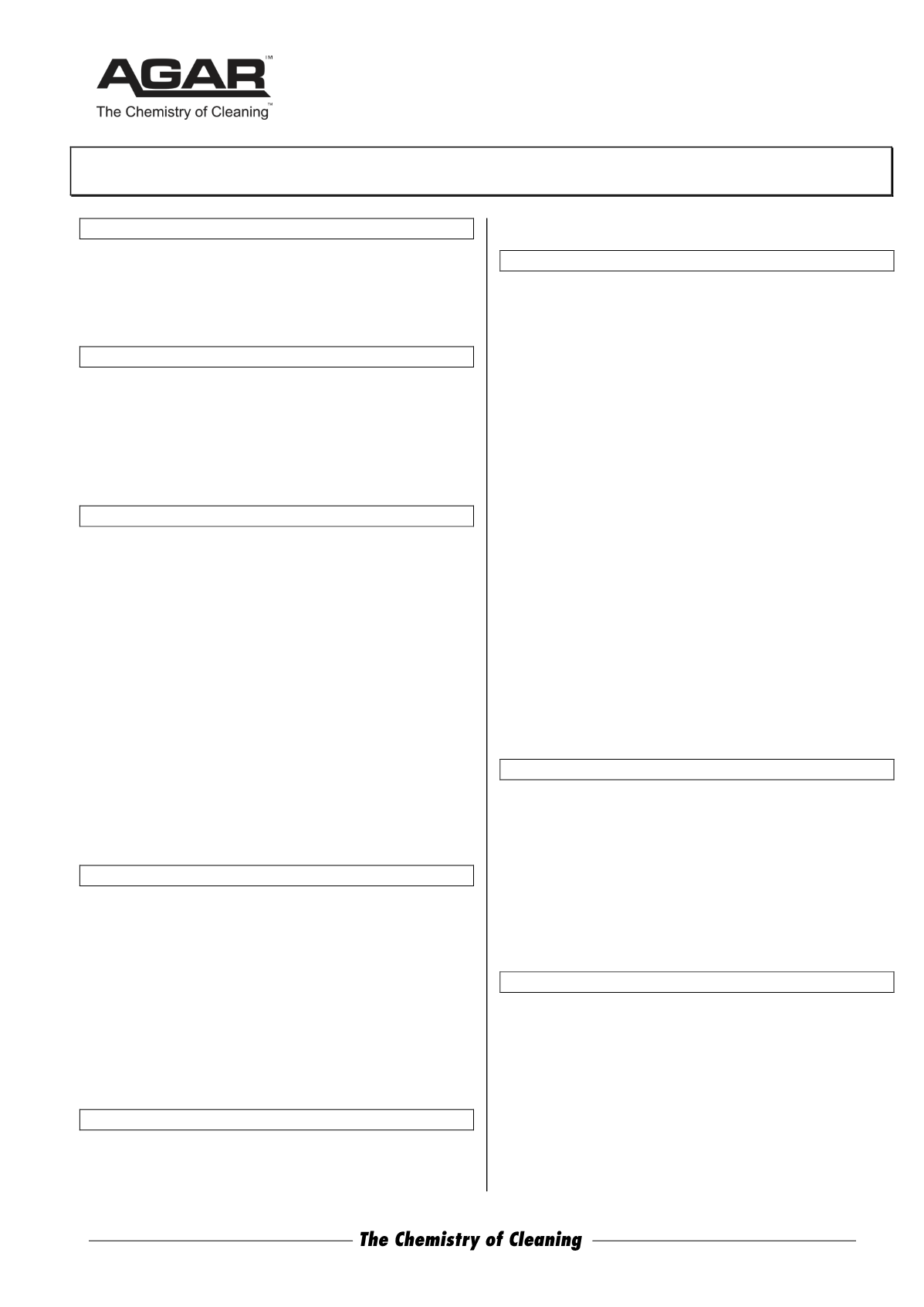

ABN 80 004 726 890 | MADE IN AUSTRALIA
Safety Data Sheet
Issued: February 28, 2012
Page 2 of 3
TYRE SHINE
6 ACCIDENTAL RELEASE MEASURES
Remove all ignition sources. Clean up all spills immediately.
Spills may be slippery. Avoid breathing vapours and contact
with skin and eyes. Contain spill and mop up, or soak up with
an inert absorbent material. Place in a suitable, labelled
container for waste disposal.
7 HANDLING AND STORAGE
Storage and Transport: Store in a cool, dry place. Avoid heat,
sparks, open flames and other ignition sources. Wear
personal protective equipment when risk of exposure occurs.
No smoking, naked lights, heat or ignition sources. Keep
containers securely sealed.
Incompatibility (Materials to avoid for purposes of transport,
handling and storage only): Avoid strong oxidizing agents.
8 EXPOSURE CONTROLS / PERSONAL PROTECTION
Exposure Standards: None assigned for mixture.
Atmospheric Contaminant Exposure Standard for:
hexane CAS No. 110-54-3 TWA = 20 ppm (72 mg/cu.m)
Peak limitation
STEL = -
[Source: Safe Work Australia HSIS- 2011]
Engineering Controls: The level of protection and types of
controls necessary will vary depending on potential exposure
conditions. Select controls based on a risk assessment of
local circumstances. Appropriate measures include: adequate
explosion-proof ventilation to control airborne concentrations
below the exposure limits.
Personal Protection:
Gloves - Wear PVC or nitrile gloves if repeated skin contact
may occur.
Eye-protection – Safety glasses with side-shields or goggles.
Respiratory – If inhalation risk exists, consider wearing a
respirator with Type AX filter of sufficient capacity.
9 PHYSICAL AND CHEMICAL PROPERTIES
Appearance: Transparent colourless liquid which does not mix
with water.
Odour: Slight solvent odour
pH = N/A
Vapour Pressure: 354 kPa@ 15 deg C
Vapour density (air=1) : >1
Boiling Point: 66 - 115°C
Freezing Point: < 0
°
C
Flash point: Typical < -20
o
C closed cup
Solubility in water: Insoluble
Specific Gravity: 0.8 - 0.9
Evaporation rate: N/K
% volatile by vol: 60 – 80%
10 STABILITY AND REACTIVITY
Stable.
Avoid heat, sparks, open flames and other ignition sources.
Avoid strong oxidising agents.
Hazardous polymerization: None.
11 TOXICOLOGICAL INFORMATION
Health Effects:
Acute -
There is limited evidence that inhalation, skin contact and/or
ingestion may cause health damage.
Swallowed: Harmful: may cause lung damage if swallowed.
Eye: Contact with eyes may result in irritation.
Skin: Principal route of exposure is usually by skin contact.
May cause some slight irritation or de-fatting.
Inhalation: Inhalation of concentrated vapours, if present, in
confined spaces may cause irritation to eyes and mucous
membranes, may cause headaches and dizziness, could be
anaesthetic and may have other central nervous system
effects. Aspiration into the lungs when swallowed or vomited
may cause chemical pneumonitis which can be fatal.
Health Effects -
Chronic
. Possible risk of impaired fertility.
Harmful: danger of serious damage to health by prolonged
exposure through inhalation. Limited evidence of carcinogenic
effect. Repeated or prolonged skin contact may cause redness
or dermatitis.
Toxicity data:
Oral (rat) LD50 = 28710 mg/kg
Inhalation (human) TCLo = 190 ppm/8W
Inhalation (rat) LD50 = 48000 ppm/4h
Irritation Eye (rabbit) = 10 mg - Mild
(Note: this data is from published information. Agar Cleaning
Systems does not carry out animal tests.)
12 ECOLOGICAL INFORMATION
Ecotoxicity: Harmful to aquatic organisms, may cause long-term
adverse effects in the aquatic environment.
Persistence and degradability: The principal hydrocarbon in this
product is expected to be biodegradable. Degrades rapidly in
air by photochemical means.
Mobility: Data for the principal hydrocarbon: Adsorbs to soil and
has low mobility. Floats on water.
Advice: Do not allow product to enter drains, waterways or
sewers.
13 DISPOSAL CONSIDERATIONS
For disposal, refer to State Land Waste Management authority
and Environmental Protection Authority. Containers may still
present a chemical hazard/danger when empty.
STEL = Short term exposure limit
CAS = Chemical Abstracts Service
N/A = Not Applicable
Please turn to Page 3


















